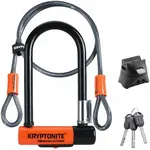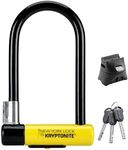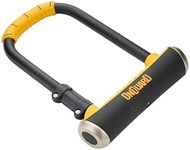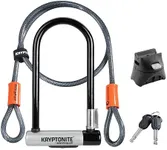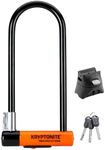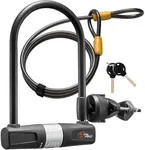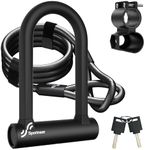Buying Guide for the Best Bike U Locks
Choosing the right bike U-lock is essential for keeping your bicycle secure when you leave it unattended. U-locks are popular because they offer a strong balance of security and convenience. When picking a U-lock, it's important to consider how and where you'll use it, what kind of bike you have, and how much weight you're willing to carry. Understanding the key features will help you find a lock that matches your needs and gives you peace of mind.SizeThe size of a U-lock refers to the length and width of the shackle, which is the U-shaped part that goes around your bike and the object you’re locking it to. Size is important because it determines what you can lock your bike to and how easily you can carry the lock. Smaller U-locks are lighter and easier to transport, but they may not fit around larger objects like thick poles or bike racks. Larger U-locks give you more flexibility in where you can lock your bike, but they can be heavier and bulkier. To pick the right size, think about the places you usually park your bike and whether you need to lock both the frame and a wheel. If you mostly lock up in areas with standard bike racks, a medium-sized U-lock is often a good balance.
Shackle ThicknessShackle thickness is the diameter of the metal used in the U-shaped part of the lock. This is important because thicker shackles are harder to cut with bolt cutters or saws, making the lock more secure. Shackle thickness usually ranges from about 10mm to 18mm. Thinner shackles are lighter and easier to carry, but offer less protection. Thicker shackles provide more security but add weight. If you park your bike in high-risk areas or leave it unattended for long periods, a thicker shackle is a better choice. For quick stops in low-risk areas, a thinner shackle may be sufficient.
Locking MechanismThe locking mechanism is how the U-lock secures itself, usually with a key or a combination. This is important because a good mechanism resists picking and tampering. Some locks have double-bolting, which means both sides of the shackle are locked, making it harder to twist open. Simpler mechanisms may be easier to use but can be less secure. If you value convenience and quick access, a key or combination you find easy to use is important. If you’re more concerned about security, look for locks with advanced mechanisms and double-bolting.
WeightWeight refers to how heavy the U-lock is, which affects how easy it is to carry with you. Heavier locks are usually more secure because they use thicker metal, but they can be a hassle to transport, especially if you ride long distances or don’t have a good way to attach the lock to your bike. Lighter locks are easier to carry but may offer less protection. Consider how far you ride and whether you have a bag or a lock mount on your bike. If you commute daily or travel long distances, a lighter lock may be more comfortable, but if you leave your bike in risky areas, a heavier lock might be worth the extra effort.
Weather ResistanceWeather resistance means how well the lock can handle rain, snow, and dirt without rusting or jamming. This is important because a lock that rusts or gets stuck can leave you stranded or make it hard to secure your bike. Some locks have protective coatings or covers to keep out water and dust. If you often park your bike outdoors or in wet conditions, look for a lock with good weather resistance. If you mostly store your bike indoors, this may be less of a concern.

